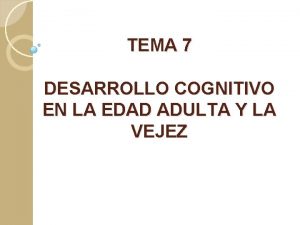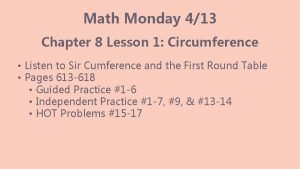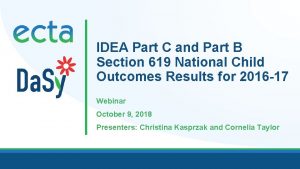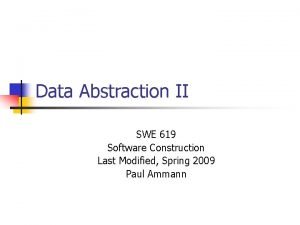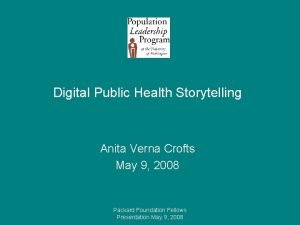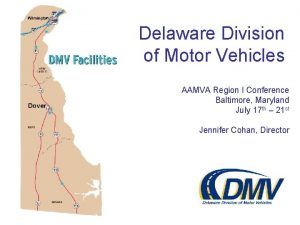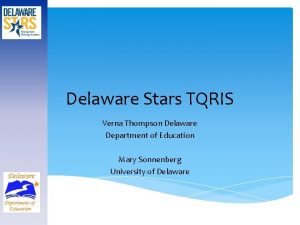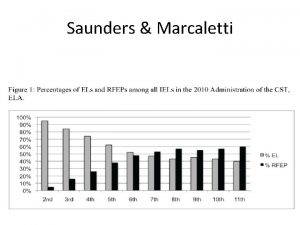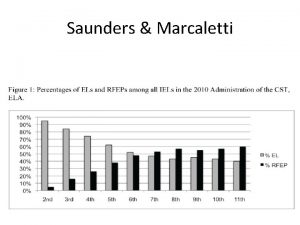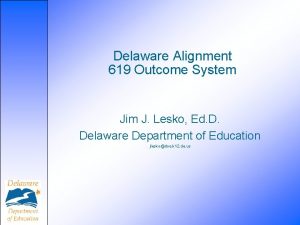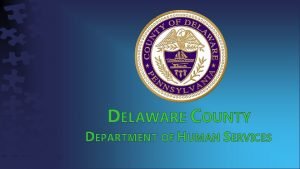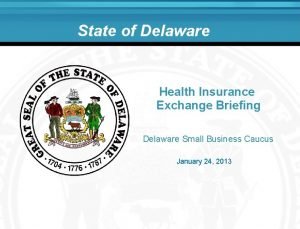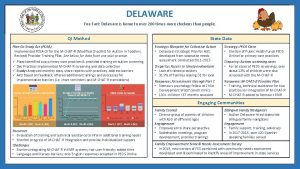Delaware 619 Meeting JANUARY 6 2014 VERNA THOMPSON



















- Slides: 19

Delaware 619 Meeting JANUARY 6, 2014 VERNA THOMPSON VERNA. THOMPSON@DOE. K 12. DE. US

Agenda �Welcome and Introductions �Child Outcomes Annual Performance Report � 619 Participation in Delaware Stars �Memorandums of Understanding �Important Dates

Welcome and Introductions Happy New Year �Thank you for sharing time together! �Introductions and sharing What is your New Year’s Resolution for 619?

Child Outcomes 2012 Indicator 7: Percent of preschool children with IEPs who demonstrate improved: �Positive social-emotional skills (including social relationships); �Acquisition and use of knowledge and skills (including early language/communication and early literacy; and �Use of appropriate behaviors to meet their needs.

Child Outcomes � Percent of preschool children who did not improve functioning = [(# of preschool � � children who did not improve functioning) divided by the (# of preschool children with IEPs assessed)] times 100. Percent of preschool children who improved functioning but not sufficient to move nearer to functioning comparable to same-aged peers = [(# of preschool children who improved functioning but not sufficient to move nearer to functioning comparable to same-aged peers) divided by the (# of preschool children with IEPs assessed)] times 100. Percent of preschool children who improved functioning to a level nearer to same-aged peers but did not reach it = [(# of preschool children who improved functioning to a level nearer to same-aged peers but did not reach it) divided by the (# of preschool children with IEPs assessed)] times 100. Percent of preschool children who improved functioning to reach a level comparable to same-aged peers = [(# of preschool children who improved functioning to reach a level comparable to same-aged peers) divided by the (# of preschool children with IEPs assessed)] times 100. Percent of preschool children who maintained functioning at a level comparable to same-aged peers = [(# of preschool children who maintained functioning at a level comparable to same-aged peers) divided by the (# of preschool children with IEPs assessed) times 100.

Child Outcomes Summary Statements: �Of those children who entered or exited the program below age expectations , the percent who substantially increased their rate of growth by the time they exited the program. �The percent of children who were functioning within age expectations by the time they exited the program.

Child Outcomes 2012

Child Outcomes 2012 A. Positive social-emotional skills (including social relationships): FFY 2012 Number of children % of children 5 0. 6% 94 11. 6% 273 33. 7% 287 35. 5% 150 18. 5% N=809 100% a. Percent of children who did not improve functioning b. Percent of children who improved functioning but not sufficient to move nearer to functioning comparable to sameaged peers c. Percent of children who improved functioning to a level nearer to same-aged peers but did not reach d. Percent of children who improved functioning to reach a level comparable to same-aged peers e. Percent of children who maintained functioning at a level comparable to same-aged peers Total

Child Outcomes 2012 A. Acquisition and use of knowledge and skills (including early language/communication and early literacy): FFY 2012 Number of children 8 % of children 1. 0% 81 10. 0% c. Percent of children who improved functioning to a level nearer to same-aged peers but did not reach 319 39. 4% d. Percent of children who improved functioning to reach a level comparable to same-aged peers 301 37. 2% e. Percent of children who maintained functioning at a level 100 12. 4% N= 809 100% a. Percent of children who did not improve functioning b. Percent of children who improved functioning but not sufficient to move nearer to functioning comparable to same-aged peers Total

Child Outcomes 2012 C. Use of appropriate behaviors to meet their needs: FFY 2012 Number of children 5 % of children 0. 6% b. Percent of children who improved functioning but not sufficient to move nearer to functioning comparable to same-aged peers 70 8. 7% c. Percent of children who improved functioning to a level nearer to same-aged peers but did not reach 176 21. 8% d. Percent of children who improved functioning to reach a level comparable to same-aged peers 330 a. functioning Percent of children who did not improve 40. 8% e. Percent of children who maintained functioning at a level comparable to same-aged peers Total 228 28. 2% N=809 100%

Child Outcomes Next Steps: �Visits to each school district to provide: Local Child Outcome data Comparisons between 2011 and 2012 Comparisons between actual data and state targets Comparisons between state and local Analysis – data quality and program evaluation �Who could be invited to meeting? Administrators? Teachers? Therapists?

Delaware Stars �Delaware Stars Work Group Meeting Date � January 15 th - needs to be rescheduled � February 12 th 9: 00 – EIEIO in afternoon �Who will be invited? 619 coordinators DIEEC – TA, Case Managers, ECERS validator DOE/OEL staff Other school district program administrators? (619 only or should Title 1 and school district ECAP also? ) Others?

Delaware Stars �Purpose of Work Group Discuss successful strategies 619 programs are implementing Determine issues related to 619 participation in Stars QRIS Determine solutions to identified issues Determine strategies to assist 619 program meet state targets Determine possible recommendations for changes to policies related to 619 participation in Stars QRIS Determine areas of support needed Other ideas?

� This agreement is entered onto by ______ School District, _____ School District for the period beginning _________. Purpose Statement The purpose of this agreement is to delineate responsibilities for screening, evaluation and provision of FAPE for preschool children in New Castle County. This agreement is for those services eligible for preschool children with disabilities until entry into Kindergarten. Upon entry into Kindergarten, preschool children will follow the same procedures for district of residence and Choice as do all Kindergarten children. For purposes of this agreement, districts will be defined as follows: District of residence: District in which the child and family live District of service : District in which the child is enrolled in a Head Start, ECAP, child care, preschool program ) {for more than _____ hours (opt)} The District of service may be the same as the district of residence or may be any of the districts that are signatory to this agreement.

MOU Between School Districts � Responsibilities of _____ County School Districts. � 1. District of service will be responsible for ensuring screening of preschool children who attend the Head Start, ECAP, child care or preschool facility which is within said district’s boundary. This reflects current practice. � 2. For those children who are enrolled in a Head Start, ECAP, child care or preschool for more than _____ hours in a district other than the district of residence, comprehensive developmental evaluations will be the responsibility of the {district of service in which child is enrolled in child care } or {district of residence}. � 3. For those families who request such, provision of FAPE will be the responsibility of the district of service in which the child is enrolled in a preschool facility (Head Start, ECAP, child care, preschool). � 4. Transportation will be provided by the district of services. � 5. For count purposes, children will be counted by the district of services. � 6. Tuition will be paid by the district of residence to the district of service for children from tuition generating programs. � 7. Early Childhood Outcomes data will be collected and reported for and by the district of services. � 8. It is incumbent upon the district of service to apprise families that entry into Kindergarten will trigger the same policies and procedures which apply to all rising Kindergarten children. The rules that govern district of residence and Choice apply to all K – 12 children. Notification of these rules that govern districts will be given to the district of service as part of the usual procedures for dissemination of Choice information. � 9. By April 15, the district of service will notify the district of residence of children who will be eligible for Kindergarten the following September. Current practice for transfer of records will apply. � 10. Dispute resolution procedures include: � Responsibilities of _____ County School Districts. � 1. District of service will be responsible for ensuring screening of preschool children who attend the Head Start, ECAP, child care or preschool facility which is within said district’s boundary. This reflects current practice. � 2. For those children who are enrolled in a Head Start, ECAP, child care or preschool for more than _____ hours in a district other than the district of residence, comprehensive developmental evaluations will be the responsibility of the {district of service in which child is enrolled in child care } or {district of residence}. � 3. For those families who request such, provision of FAPE will be the responsibility of the district of service in which the child is enrolled in a preschool facility (Head Start, ECAP, child care, preschool). � 4. Transportation will be provided by the district of services. � 5. For count purposes, children will be counted by the district of services. � 6. Tuition will be paid by the district of residence to the district of service for children from tuition generating programs.

MOU Between School Districts �Additions to MOU �Deletions �Questions to be answered �Issues to be resolved

Future Dates to Remember �February 12 EIEIO �February 27 Still Listening Conference �TBA 619/Stars Work Group Ages and Stages Training Next 619 Meeting

Other Issues �Next Steps

�Thank you for coming!
 Desarrollo cognitivo en la edad adulta
Desarrollo cognitivo en la edad adulta Jeff offutt
Jeff offutt Requisitos de los títulos valores
Requisitos de los títulos valores Lesson 1 extra practice circumference
Lesson 1 extra practice circumference Sf 619
Sf 619 Xkcd pointers
Xkcd pointers Swe 619
Swe 619 Idea part b section 619
Idea part b section 619 Comp309
Comp309 Swe 619
Swe 619 Round 2 617 to the nearest ten
Round 2 617 to the nearest ten Swe 619 gmu
Swe 619 gmu Sam and verna barriers
Sam and verna barriers Anita verna crofts
Anita verna crofts What is meeting and types of meeting
What is meeting and types of meeting Proposal kickoff meeting agenda
Proposal kickoff meeting agenda For todays meeting
For todays meeting What is meeting and types of meeting
What is meeting and types of meeting Emanuel leutze
Emanuel leutze Delaware division of motor vehicles
Delaware division of motor vehicles
